Optimizing Ecological Management in China: Insights from Chongqing’s Service Projections
Abstract
1. Introduction
2. Methodology and Data Sources
2.1. Study Area
2.2. Data Source
2.3. Research Framework
2.4. Assessing ES Supply and Demand
2.5. Geographically Weighted Regression Model
2.6. Scenario Analysis
3. Results
3.1. Changes in ES Supply and Demand Patterns
3.2. Driving Forces of ES Changes
3.3. Projections Under SSP–RCP Scenarios
4. Discussion
4.1. Mismatch in ES Supply and Demand
4.2. The Impact of Different SSP–RCP Scenario in Future
4.3. Uncertainty Analysis and Future Research Directions
5. Conclusions and Policy Implications
Supplementary Materials
Author Contributions
Funding
Data Availability Statement
Acknowledgments
Conflicts of Interest
References
- Dooley, E.E. Millennium ecosystem assessment. Environ. Health Perspect. 2005, 113, A591. [Google Scholar] [CrossRef]
- Costanza, R.; Arge, R.D.; de Groot, R.; Farber, S.; Grasso, M.; Hannon, B.; Limburg, K.; Naeem, S.; Robert, V.; O’Neill, R.D.; et al. The value of the world’s ecosystem services and natural capital (cover story). Nature 1997, 387, 253–260. [Google Scholar] [CrossRef]
- Ehrlich, P.; Ehrlich, A. Extinction: The Causes and Consequences of the Disappearance of Species. Q. Rev. Biol. 1981, 40, 82–85. [Google Scholar]
- Finlayson, C.M. The Economics of Ecosystems and Biodiversity (TEEB). In The Wetland Book: I: Structure and Function, Management, and Methods; Finlayson, C.M., Everard, M., Irvine, K., McInnes, R.J., Middleton, B.A., van Dam, A.A., Davidson, N.C., Eds.; Springer: Heidelberg, Germany, 2018; pp. 335–339. [Google Scholar]
- Maes, J.; Liquete, C.; Teller, A.; Erhard, M.; Paracchini, M.L.; Barredo, J.I.; Grizzetti, B.; Cardoso, A.; Somma, F.; Petersen, J.E.; et al. An indicator framework for assessing ecosystem services in support of the eu biodiversity strategy to 2020. Ecosyst. Serv. 2016, 17, 14–23. [Google Scholar] [CrossRef]
- Harwell, M.C.; Jackson, C.A. Synthesis of Two Decades of US EPA’s Ecosystem Services Research to Inform Environmental, Community, and Sustainability Decision Making. Sustainability 2021, 13, 8249. [Google Scholar] [CrossRef]
- Cork, S.J.; Shelton, D. The Nature and Value of Australia’s Ecosystem Services: A Framework for Sustainable Environmental Solutions. In Proceedings of the 3rd Queensland Environmental Conference: Sustainable Environmental Solutions for Industry and Government; a Focus of Sound, Practical and Economically Viable Solutions for Industry and Government, Brisbane, QLD, Australia, 1 January 2000; pp. 151–159. [Google Scholar]
- Hanes, R.J.; Gopalakrishnan, V.; Bakshi, B.R. Synergies and trade-offs in renewable energy landscapes: Balancing energy production with economics and ecosystem services. Appl. Energy 2017, 199, 25–44. [Google Scholar] [CrossRef]
- Ni, Y.C.; Wei, J.X.; Wu, T.; Guo, M.; Han, Q.Y.; Zhang, M.J. Mapping and assessing ecosystem service supply-demand to identify critical areas: A case study of a waterside area in Shanghai metropolitan area. Front. Earth Sci. 2022, 10, 943910. [Google Scholar] [CrossRef]
- Ouyang, Z.Y.; Song, C.S.; Zheng, H.; Polasky, S.; Xiao, Y.; Bateman, I.J.; Liu, J.G.; Ruckelshaus, M.; Shi, F.Q.; Xiao, Y.; et al. Using gross ecosystem product (GEP) to value nature in decision making. Proc. Natl. Acad. Sci. USA 2020, 117, 14593–14601. [Google Scholar] [CrossRef]
- Wang, D.; Liang, Y.J.; Peng, S.Z.; Yin, Z.C.; Huang, J.J. Integrated assessment of the supply-demand relationship of ecosystem services in the Loess Plateau during 1992–2015. Ecosyst. Health Sustain. 2022, 8, 2130093. [Google Scholar] [CrossRef]
- Wang, Z.F. Evolving landscape-urbanization relationships in contemporary China. Landsc. Urban Plan. 2018, 171, 30–41. [Google Scholar] [CrossRef]
- Tao, Y.; Li, F.; Crittenden, J.C.; Lu, Z.M.; Sun, X. Environmental Impacts of China’s Urbanization from 2000 to 2010 and Management Implications. Environ. Manag. 2016, 57, 498–507. [Google Scholar] [CrossRef]
- Jiang, H.; Peng, J.; Dong, J.Q.; Zhang, Z.M.; Xu, Z.H.; Meersmans, J. Linking ecological background and demand to identify ecological security patterns across the Guangdong-Hong Kong-Macao Greater Bay Area in China. Landsc. Ecol. 2021, 36, 2135–2150. [Google Scholar] [CrossRef]
- Li, X.; Yu, X.; Wu, K.N.; Feng, Z.; Liu, Y.N.; Li, X.L. Land-use zoning management to protecting the Regional Key Ecosystem Services: A case study in the city belt along the Chaobai River, China. Sci. Total Environ. 2021, 762, 143167. [Google Scholar] [CrossRef] [PubMed]
- Meng, Q.X.; Zhang, L.K.; Wei, H.J.; Cai, E.X.; Xue, D.; Liu, M.X. Linking Ecosystem Service Supply-Demand Risks and Regional Spatial Management in the Yihe River Basin, Central China. Land 2021, 10, 843. [Google Scholar] [CrossRef]
- Zhuang, Z.C.; Li, C.; Hsu, W.L.; Gu, S.H.; Hou, X.S.; Zhang, C.M. Spatiotemporal Changes in the Supply and Demand of Ecosystem Services in China’s Huai River Basin and Their Influencing Factors. Water 2022, 14, 2559. [Google Scholar] [CrossRef]
- Xie, G.D.; Zhang, C.X.; Zhang, L.M.; Chen, W.H.; Li, S. Improvement of the evaluation method for ecosystem service value based on per unit area. J. Nat. Resour 2015, 30, 1243–1254. [Google Scholar] [CrossRef]
- Wang, B.J.; Tang, H.P.; Zhang, Q.; Cui, F.Q. Exploring Connections among Ecosystem Services Supply, Demand and Human Well-Being in a Mountain-Basin System, China. Int. J. Environ. Res. Public Health 2020, 17, 5309. [Google Scholar] [CrossRef]
- Wang, J.; Zhai, T.L.; Lin, Y.F.; Kong, X.S.; He, T. Spatial imbalance and changes in supply and demand of ecosystem services in China. Sci. Total Environ. 2019, 657, 781–791. [Google Scholar] [CrossRef]
- Zhao, H.; Li, C.; Gao, M.H. Investigation of the Relationship between Supply and Demand of Ecosystem Services and the Influencing Factors in Resource-Based Cities in China. Sustainability 2023, 15, 7397. [Google Scholar] [CrossRef]
- Shen, J.S.; Li, S.C.; Wang, H.; Wu, S.Y.; Liang, Z.; Zhang, Y.T.; Wei, F.L.; Li, S.; Ma, L.; Wang, Y.Y.; et al. Understanding the spatial relationships and drivers of ecosystem service supply-demand mismatches towards spatially-targeted management of social-ecological system. J. Clean. Prod. 2023, 406, 136882. [Google Scholar] [CrossRef]
- Wei, W.; Nan, S.X.; Xie, B.B.; Liu, C.F.; Zhou, J.J.; Liu, C.Y. The spatial-temporal changes of supply-demand of ecosystem services and ecological compensation: A case study of Hexi Corridor, Northwest China. Ecol. Eng. 2023, 187, 106861. [Google Scholar] [CrossRef]
- Zhao, C.; Xiao, P.N.; Qian, P.; Xu, J.; Yang, L.; Wu, Y.X. Spatiotemporal Differentiation and Balance Pattern of Ecosystem Service Supply and Demand in the Yangtze River Economic Belt. Int. J. Environ. Res. Public Health 2022, 19, 7223. [Google Scholar] [CrossRef]
- Men, D.; Pan, J.H.; Sun, X.W. Spatial and temporal patterns of supply and demand risk for ecosystem services in the Weihe River Main Stream, NW China. Environ. Sci. Pollut. Res. 2022, 30, 36952–36966. [Google Scholar] [CrossRef] [PubMed]
- Chen, F.Y.; Li, L.; Niu, J.Q.; Lin, A.W.; Chen, S.Y.; Hao, L. Evaluating Ecosystem Services Supply and Demand Dynamics and Ecological Zoning Management in Wuhan, China. Int. J. Environ. Res. Public Health 2019, 16, 2332. [Google Scholar] [CrossRef]
- Shui, W.; Wu, K.X.; Du, Y.; Yang, H.F. The Trade-Offs between Supply and Demand Dynamics of Ecosystem Services in the Bay Areas of Metropolitan Regions: A Case Study in Quanzhou, China. Land 2022, 11, 22. [Google Scholar] [CrossRef]
- Yan, X.L.; Liu, C.H.; Han, Z.L.; Li, X.Y.; Zhong, J.Q. Spatiotemporal assessment of ecosystem services supply-demand relationships to identify ecological management zoning in coastal city Dalian, China. Environ. Sci. Pollut. Res. 2023, 30, 63464–63478. [Google Scholar] [CrossRef] [PubMed]
- Zhou, L.L.; Zhang, H.Z.; Bi, G.H.; Su, K.C.; Wang, L.; Chen, H.J.; Yang, Q.Y. Multiscale perspective research on the evolution characteristics of the ecosystem services supply-demand relationship in the chongqing section of the three gorges reservoir area. Ecol. Indic. 2022, 142, 109227. [Google Scholar] [CrossRef]
- Wu, X.; Liu, S.L.; Zhao, S.; Hou, X.Y.; Xu, J.W.; Dong, S.K.; Liu, G.H. Quantification and driving force analysis of ecosystem services supply, demand and balance in China. Sci. Total Environ. 2019, 652, 1375–1386. [Google Scholar] [CrossRef]
- Luo, Z.L.; Zuo, Q.T.; Shao, Q.X. A new framework for assessing river ecosystem health with consideration of human service demand. Sci. Total Environ. 2018, 640, 442–453. [Google Scholar] [CrossRef]
- Jing, Y.C.; Chen, L.; Sun, R. A theoretical research framework for ecological security pattern construction based on ecosystem services supply and demand. Acta Ecol. Sin. 2018, 38, 4121–4131. [Google Scholar]
- Xiao, P.N.; Zhao, C.; Zhou, Y.; Feng, H.Y.; Li, X.G.; Jiang, J.H. Study on Land Consolidation Zoning in Hubei Province Based on the Coupling of Neural Network and Cluster Analysis. Land 2021, 10, 756. [Google Scholar] [CrossRef]
- Zhang, Y.C.; Chen, Z.; Zhang, Y.; Mei, M. Urban Ecological Importance Assessment Based on Ecological Function and Ecological Demand:A Case Study of Changsha. Resour. Environ. Yangtze Basin 2018, 27, 2358–2367. [Google Scholar]
- Liu, W.; Zhan, J.Y.; Zhao, F.; Wang, C.; Zhang, F.; Teng, Y.M.; Chu, X.; Kumi, M.A. Spatio-temporal variations of ecosystem services and their drivers in the Pearl River Delta, China. J. Clean. Prod. 2022, 337, 130466. [Google Scholar] [CrossRef]
- Yan, K.; Wang, W.F.; Li, Y.H.; Wang, X.F.; Jin, J.X.; Jiang, J.; Yang, H.Q.; Wang, L.J. Identifying priority conservation areas based on ecosystem services change driven by Natural Forest Protection Project in Qinghai province, China. J. Clean. Prod. 2022, 362, 132453. [Google Scholar] [CrossRef]
- Guo, B.; Zang, W.Q.; Luo, W. Spatial-temporal shifts of ecological vulnerability of Karst Mountain ecosystem-impacts of global change and anthropogenic interference. Sci. Total Environ. 2020, 741, 140256. [Google Scholar] [CrossRef]
- Lv, X.J.; Xiao, W.; Zhao, Y.L.; Zhang, W.K.; Li, S.C.; Sun, H.X. Drivers of spatio-temporal ecological vulnerability in an arid, coal mining region in Western China. Ecol. Indic. 2019, 106, 105475. [Google Scholar] [CrossRef]
- Ming, L.; Chang, J.; Li, C.; Chen, Y.D.; Li, C.K. Spatial-Temporal Patterns of Ecosystem Services Supply-Demand and Influencing Factors: A Case Study of Resource-Based Cities in the Yellow River Basin, China. Int. J. Environ. Res. Public Health 2022, 19, 16100. [Google Scholar] [CrossRef] [PubMed]
- Wang, L.J.; Gong, J.W.; Ma, S.; Wu, S.; Zhang, X.M.; Jiang, J. Ecosystem service supply-demand and socioecological drivers at different spatial scales in Zhejiang Province, China. Ecol. Indic. 2022, 140, 109058. [Google Scholar] [CrossRef]
- Mashizi, A.K.; Sharafatmandrad, M. Investigating tradeoffs between supply, use and demand of ecosystem services and their effective drivers for sustainable environmental management. J. Environ. Manag. 2021, 289, 112534. [Google Scholar] [CrossRef]
- Spake, R.; Lasseur, R.; Crouzat, E.; Bullock, J.M.; Lavorel, S.; Parks, K.E.; Schaafsma, M.; Bennett, E.M.; Maes, J.; Mulligan, M.; et al. Unpacking ecosystem service bundles: Towards predictive mapping of synergies and trade-offs between ecosystem services. Glob. Environ. Change-Hum. Policy Dimens. 2017, 47, 37–50. [Google Scholar] [CrossRef]
- Lu, H.T.; Yan, Y.; Zhu, J.Y.; Jin, T.T.; Liu, G.H.; Wu, G.; Stringer, L.C.; Dallimer, M. Spatiotemporal Water Yield Variations and Influencing Factors in the Lhasa River Basin, Tibetan Plateau. Water 2020, 12, 1498. [Google Scholar] [CrossRef]
- Su, C.H.; Fu, B.J. Evolution of ecosystem services in the Chinese Loess Plateau under climatic and land use changes. Glob. Planet. Change 2013, 101, 119–128. [Google Scholar] [CrossRef]
- Underwood, E.C.; Hollander, A.D.; Safford, H.D.; Kim, J.B.; Srivastava, L.; Drapek, R.J. The impacts of climate change on ecosystem services in southern California. Ecosyst. Serv. 2019, 39, 101008. [Google Scholar] [CrossRef]
- Streimikiene, D.; Balezentis, T.; Krisciukaitiene, I. Promoting interactions between local climate change mitigation, sustainable energy development, and rural development policies in Lithuania. Energy Policy 2012, 50, 699–710. [Google Scholar] [CrossRef]
- Pham, H.V.; Sperotto, A.; Torresan, S.; Acuna, V.; Jorda-Capdevila, D.; Rianna, G.; Marcomini, A.; Critto, A. Coupling scenarios of climate and land-use change with assessments of potential ecosystem services at the river basin scale. Ecosyst. Serv. 2019, 40, 101045. [Google Scholar] [CrossRef]
- Salimi, S.; Scholz, M. Impact of future climate scenarios on peatland and constructed wetland water quality: A mesocosm experiment within climate chambers. J. Environ. Manag. 2021, 289, 112459. [Google Scholar] [CrossRef]
- Schirpke, U.; Kohler, M.; Leitinger, G.; Fontana, V.; Tasser, E.; Tappeiner, U. Future impacts of changing land-use and climate on ecosystem services of mountain grassland and their resilience. Ecosyst. Serv. 2017, 26, 79–94. [Google Scholar] [CrossRef]
- Hamlet, A.F.; Lee, S.Y.; Mickelson, K.E.B.; Elsner, M.M. Effects of projected climate change on energy supply and demand in the Pacific Northwest and Washington State. Clim. Chang. 2010, 102, 103–128. [Google Scholar] [CrossRef]
- Raymond, L.; Gotham, D.; McClain, W.; Mukherjee, S.; Nateghi, R.; Preckel, P.V.; Schubert, P.; Singh, S.; Wachs, E. Projected climate change impacts on Indiana’s Energy demand and supply. Clim. Chang. 2020, 163, 1933–1947. [Google Scholar] [CrossRef]
- Wei, H.J.; Fan, W.G.; Wang, X.C.; Lu, N.C.; Dong, X.B.; Zhao, Y.N.; Ya, X.J.; Zhao, Y.F. Integrating supply and social demand in ecosystem services assessment: A review. Ecosyst. Serv. 2017, 25, 15–27. [Google Scholar] [CrossRef]
- Larondelle, N.; Lauf, S. Balancing demand and supply of multiple urban ecosystem services on different spatial scales. Ecosyst. Serv. 2016, 22, 18–31. [Google Scholar] [CrossRef]
- Ala-Hulkko, T.; Kotavaara, O.; Alahuhta, J.; Hjort, J. Mapping supply and demand of a provisioning ecosystem service across Europe. Ecol. Indic. 2019, 103, 520–529. [Google Scholar] [CrossRef]
- Li, K.; Hou, Y.; Andersen, P.S.; Xin, R.H.; Rong, Y.J.; Skov-Petersen, H. An ecological perspective for understanding regional integration based on ecosystem service budgets, bundles, and flows: A case study of the Jinan metropolitan area in China. J. Environ. Manag. 2022, 305, 114371. [Google Scholar] [CrossRef]
- Brunsdon, C.; Fotheringham, A.S.; Charlton, M.E. Geographically Weighted Regression: A Method for Exploring Spatial Nonstationarity. Geogr. Anal. 1996, 28, 281–298. [Google Scholar] [CrossRef]
- Hezaveh, A.M.; Arvin, R.; Cherry, C.R. A geographically weighted regression to estimate the comprehensive cost of traffic crashes at a zonal level. Accid. Anal. Prev. 2019, 131, 15–24. [Google Scholar] [CrossRef] [PubMed]
- Pan, Z.Z.; Gao, G.Y.; Fu, B.J. Spatiotemporal changes and driving forces of ecosystem vulnerability in the Yangtze River Basin, China: Quantification using habitat-structure-function framework. Sci. Total Environ. 2022, 835, 155494. [Google Scholar] [CrossRef]
- Qu, S.; Wang, L.; Lin, A.; Yu, D.; Yuan, M.; Li, C.a. Distinguishing the impacts of climate change and anthropogenic factors on vegetation dynamics in the Yangtze River Basin, China. Ecol. Indic. 2020, 108, 105724. [Google Scholar] [CrossRef]
- Change, N.C. The CMIP6 landscape. Nat. Clim. Chang. 2019, 9, 727. [Google Scholar] [CrossRef]
- O’Neill, B.C.; Kriegler, E.; Ebi, K.L.; Kemp-Benedict, E.; Riahi, K.; Rothman, D.S.; van Ruijven, B.J.; van Vuuren, D.P.; Birkmann, J.; Kok, K.; et al. The roads ahead: Narratives for shared socioeconomic pathways describing world futures in the 21st century. Glob. Environ. Change-Hum. Policy Dimens. 2017, 42, 169–180. [Google Scholar] [CrossRef]
- Arnell, N.W.; Lloyd-Hughes, B. The global-scale impacts of climate change on water resources and flooding under new climate and socio-economic scenarios. Clim. Chang. 2014, 122, 127–140. [Google Scholar] [CrossRef]
- Rogelj, J.; Popp, A.; Calvin, K.V.; Luderer, G.; Emmerling, J.; Gernaat, D.; Fujimori, S.; Strefler, J.; Hasegawa, T.; Marangoni, G.; et al. Scenarios towards limiting global mean temperature increase below 1.5 degrees C. Nat. Clim. Chang. 2018, 8, 325–332. [Google Scholar] [CrossRef]
- Cook, B.I.; Mankin, J.S.; Marvel, K.; Williams, A.P.; Smerdon, J.E.; Anchukaitis, K.J. Twenty-First Century Drought Projections in the CMIP6 Forcing Scenarios. Earths Future 2020, 8, e2019EF001461. [Google Scholar] [CrossRef]
- Thomson, A.M.; Calvin, K.V.; Smith, S.J.; Kyle, G.P.; Volke, A.; Patel, P.; Delgado-Arias, S.; Bond-Lamberty, B.; Wise, M.A.; Clarke, L.E.; et al. RCP4.5: A pathway for stabilization of radiative forcing by 2100. Clim. Chang. 2011, 109, 77–94. [Google Scholar] [CrossRef]
- Riahi, K.; Rao, S.; Krey, V.; Cho, C.H.; Chirkov, V.; Fischer, G.; Kindermann, G.; Nakicenovic, N.; Rafaj, P. RCP 8.5-A scenario of comparatively high greenhouse gas emissions. Clim. Chang. 2011, 109, 33–57. [Google Scholar] [CrossRef]
- Scheiter, S.; Kumar, D.; Corlett, R.T.; Gaillard, C.; Langan, L.; Lapuz, R.S.; Martens, C.; Pfeiffer, M.; Tomlinson, K.W. Climate change promotes transitions to tall evergreen vegetation in tropical Asia. Glob. Chang. Biol. 2020, 26, 5106–5124. [Google Scholar] [CrossRef] [PubMed]
- Fahrig, L. Effects of habitat fragmentation on biodiversity. Annu. Rev. Ecol. Evol. Syst. 2003, 34, 487–515. [Google Scholar] [CrossRef]
- Micheli, F.; Mumby, P.J.; Brumbaugh, D.R.; Broad, K.; Dahlgren, C.P.; Harborne, A.R.; Holmes, K.E.; Kappel, C.V.; Litvin, S.Y.; Sanchirico, J.N. High vulnerability of ecosystem function and services to diversity loss in Caribbean coral reefs. Biol. Conserv. 2014, 171, 186–194. [Google Scholar] [CrossRef]
- Lu, Z.Y.F.; Li, W.; Yue, R.W. Investigation of the long-term supply-demand relationships of ecosystem services at multiple scales under SSP-RCP scenarios to promote ecological sustainability in China’s largest city cluster. Sustain. Cities Soc. 2024, 104, 105295. [Google Scholar] [CrossRef]
- Lewis, S.L.; Wheeler, C.E.; Mitchard, E.T.A.; Koch, A. Regenerate natural forests to store carbon. Nature 2019, 568, 25–28. [Google Scholar] [CrossRef]
- Hua, F.; Bruijnzeel, L.A.; Meli, P.; Martin, P.A.; Zhang, J.; Nakagawa, S.; Miao, X.; Wang, W.; McEvoy, C.; Peña-Arancibia, J.L.; et al. The biodiversity and ecosystem service contributions and trade-offs of forest restoration approaches. Science 2022, 376, 839–844. [Google Scholar] [CrossRef]
- Lu, H.T.; Stringer, L.C.; Yan, Y.; Wang, C.X.; Zhao, C.L.; Rong, Y.J.; Zhu, J.Y.; Wu, G.; Martin, D. Mapping ecosystem service supply and demand:historical changes and projections under SSP-RCP scenarios. Acta Ecol. Sin. 2023, 43, 1309–1325. [Google Scholar]
- Xia, H.; Liu, M. Hu Huanyong Line based on geographical synthesis: Simulation and prediction under SSPs-RCPs scenario matrix. Geogr. Res. 2022, 40, 2838–2855. [Google Scholar]
- Zhang, L.; Bai, Y.; Hu, Y.; Deng, X.; Liu, W. Valuation of ecosystem services in China under different SSP-RCP scenarios. Acta Ecol. Sin. 2023, 43, 510–521. [Google Scholar] [CrossRef]
- Chen, T.; Huang, Q.; Wang, Q. Ecological security zoning identification of Chengdu-Chongqing urban agglomeration based on supply-demand relationship of ecosystem services. Mt. Res. 2022, 40, 727–740. [Google Scholar]
- Guan, Y.R.; Shan, Y.L.; Huang, Q.; Chen, H.L.; Wang, D.; Hubacek, K. Assessment to China’s Recent Emission Pattern Shifts. Earths Future 2021, 9, e2021EF002241. [Google Scholar] [CrossRef]
- Liu, L.; Zhang, X.; Gao, Y.; Chen, X.; Xie, S.; Mi, J. Finer-Resolution Mapping of Global Land Cover: Recent Developments, Consistency Analysis, and Prospects. J. Remote Sens. 2021, 2021, 1–38. [Google Scholar] [CrossRef]
- Shan, Y.L.; Guan, D.B.; Zheng, H.R.; Ou, J.M.; Li, Y.; Meng, J.; Mi, Z.F.; Liu, Z.; Zhang, Q. Data Descriptor: China CO2 emission accounts 1997–2015. Sci. Data 2018, 5, 170201. [Google Scholar]
- Shan, Y.L.; Huang, Q.; Guan, D.B.; Hubacek, K. China CO2 emission accounts 2016–2017. Sci. Data 2020, 7, 54. [Google Scholar]
- Shan, Y.L.; Liu, J.H.; Liu, Z.; Xu, X.W.H.; Shao, S.; Wang, P.; Guan, D.B. New provincial CO2 emission inventories in China based on apparent energy consumption data and updated emission factors. Appl. Energy 2016, 184, 742–750. [Google Scholar]
- Hutchinson, M.F.; Xu, T. Anusplin Version 4.4 User Guide; Fenner School of Environment and Society, Australian National University: Canberra, Australia, 2013. [Google Scholar]
- Yang, J.L.; Dong, J.W.; Xiao, X.M.; Dai, J.H.; Wu, C.Y.; Xia, J.Y.; Zhao, G.S.; Zhao, M.M.; Li, Z.L.; Zhang, Y.; et al. Divergent shifts in peak photosynthesis timing of temperate and alpine grasslands in China. Remote Sens. Environ. 2019, 233, 111395. [Google Scholar]
- Zhang, X.; Liu, L.Y.; Chen, X.D.; Gao, Y.; Xie, S.; Mi, J. GLC_FCS30: Global land-cover product with fine classification system at 30m using time-series Landsat imagery. Earth Syst. Sci. Data 2021, 13, 2753–2776. [Google Scholar] [CrossRef]
- Zhang, X.; Liu, L.Y.; Wu, C.S.; Chen, X.D.; Gao, Y.; Xie, S.; Zhang, B. Development of a global 30m impervious surface map using multisource and multitemporal remote sensing datasets with the Google Earth Engine platform. Earth Syst. Sci. Data 2020, 12, 1625–1648. [Google Scholar] [CrossRef]
- Zhang, X.; Liu, L.Y.; Zhao, T.T.; Gao, Y.; Chen, X.D.; Mi, J. GISD30: Global 30 m impervious-surface dynamic dataset from 1985 to 2020 using time-series Landsat imagery on the Google Earth Engine platform. Earth Syst. Sci. Data 2022, 14, 1831–1856. [Google Scholar] [CrossRef]
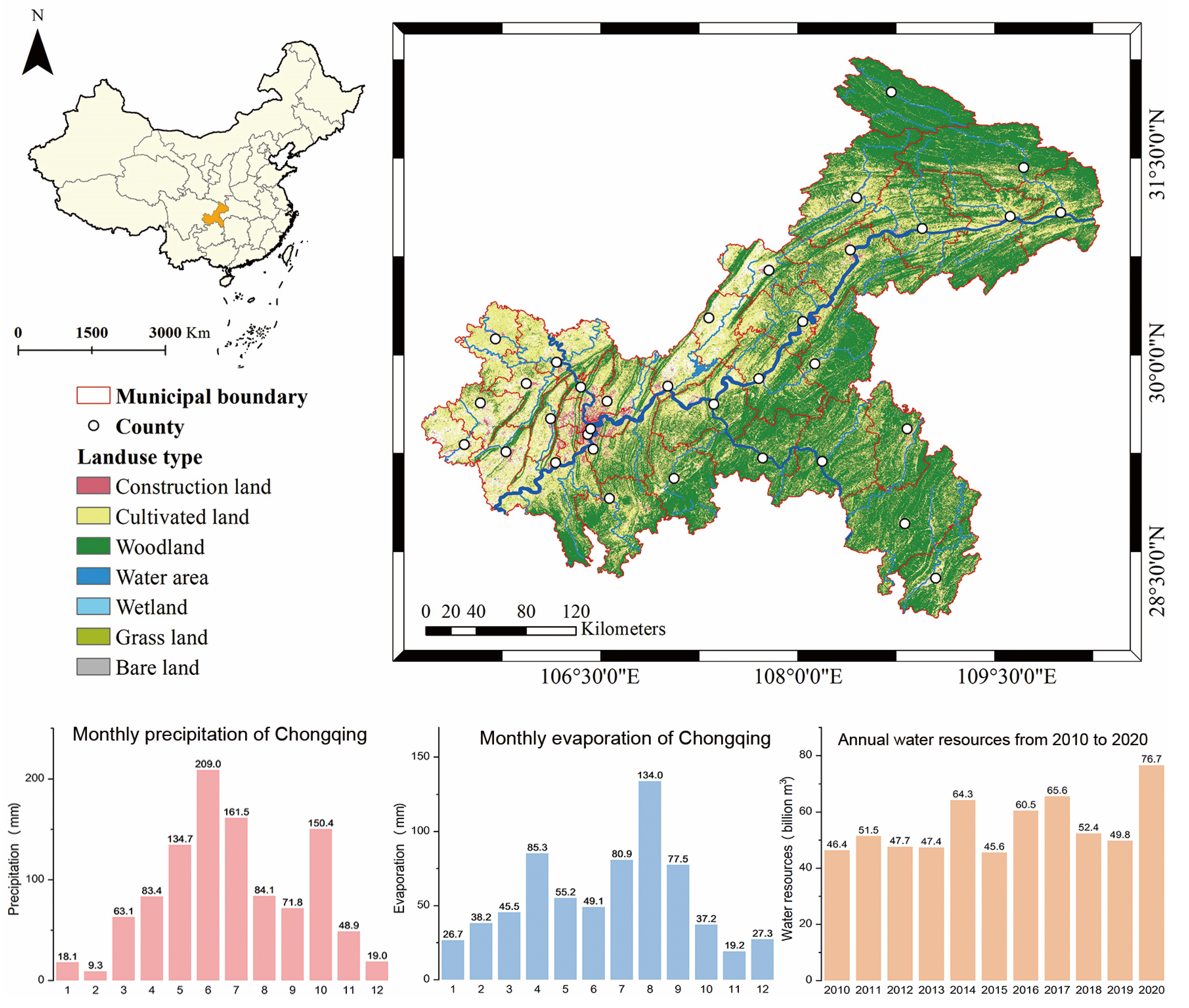
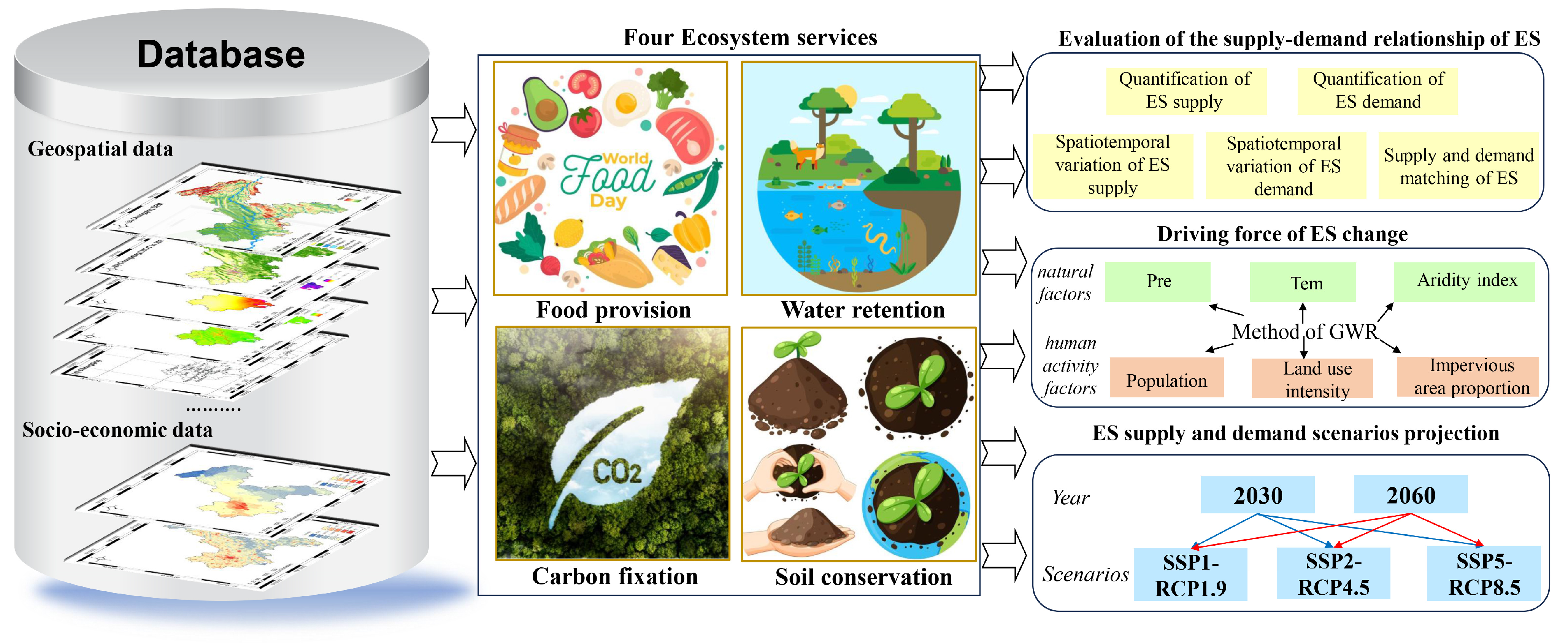
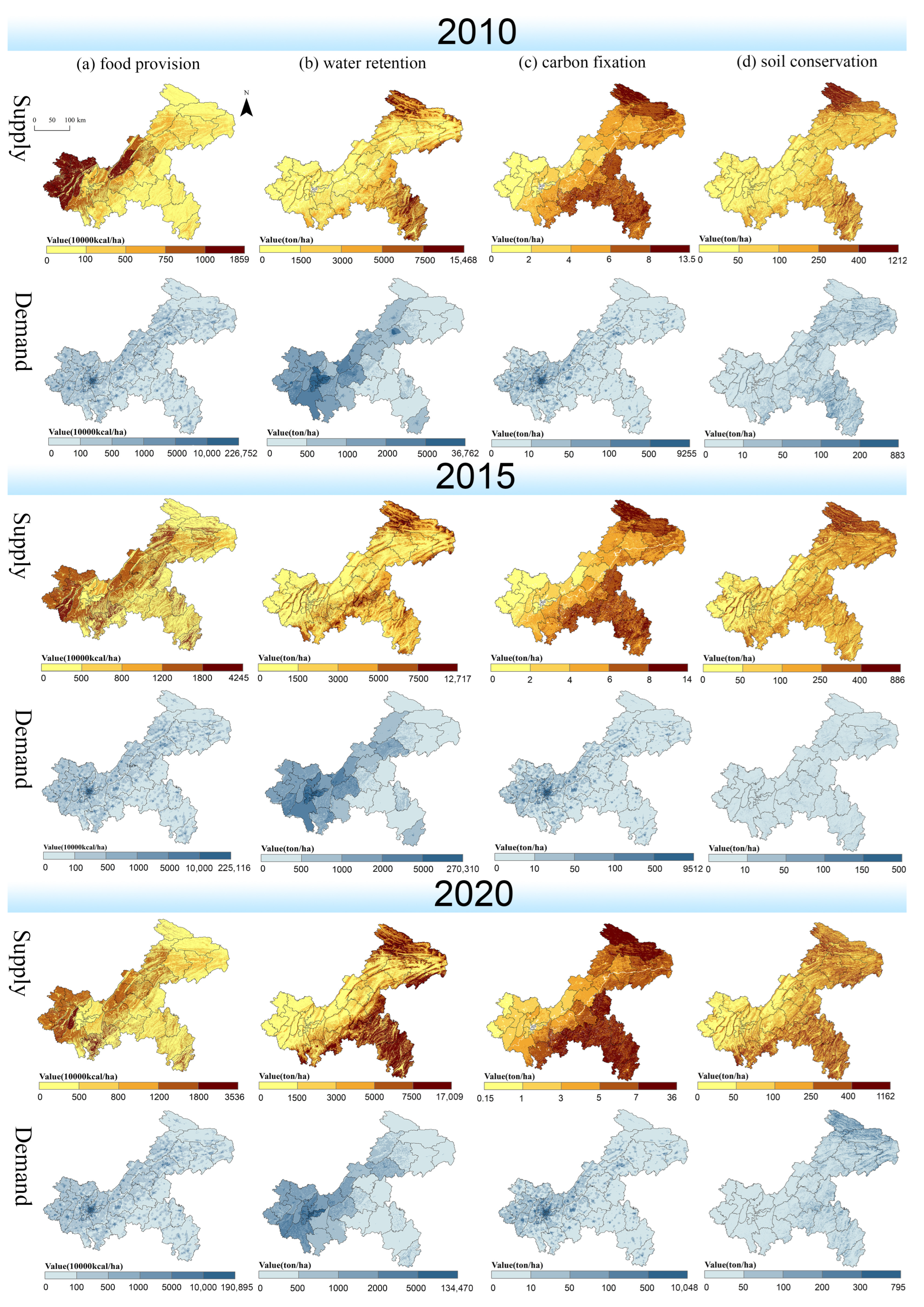
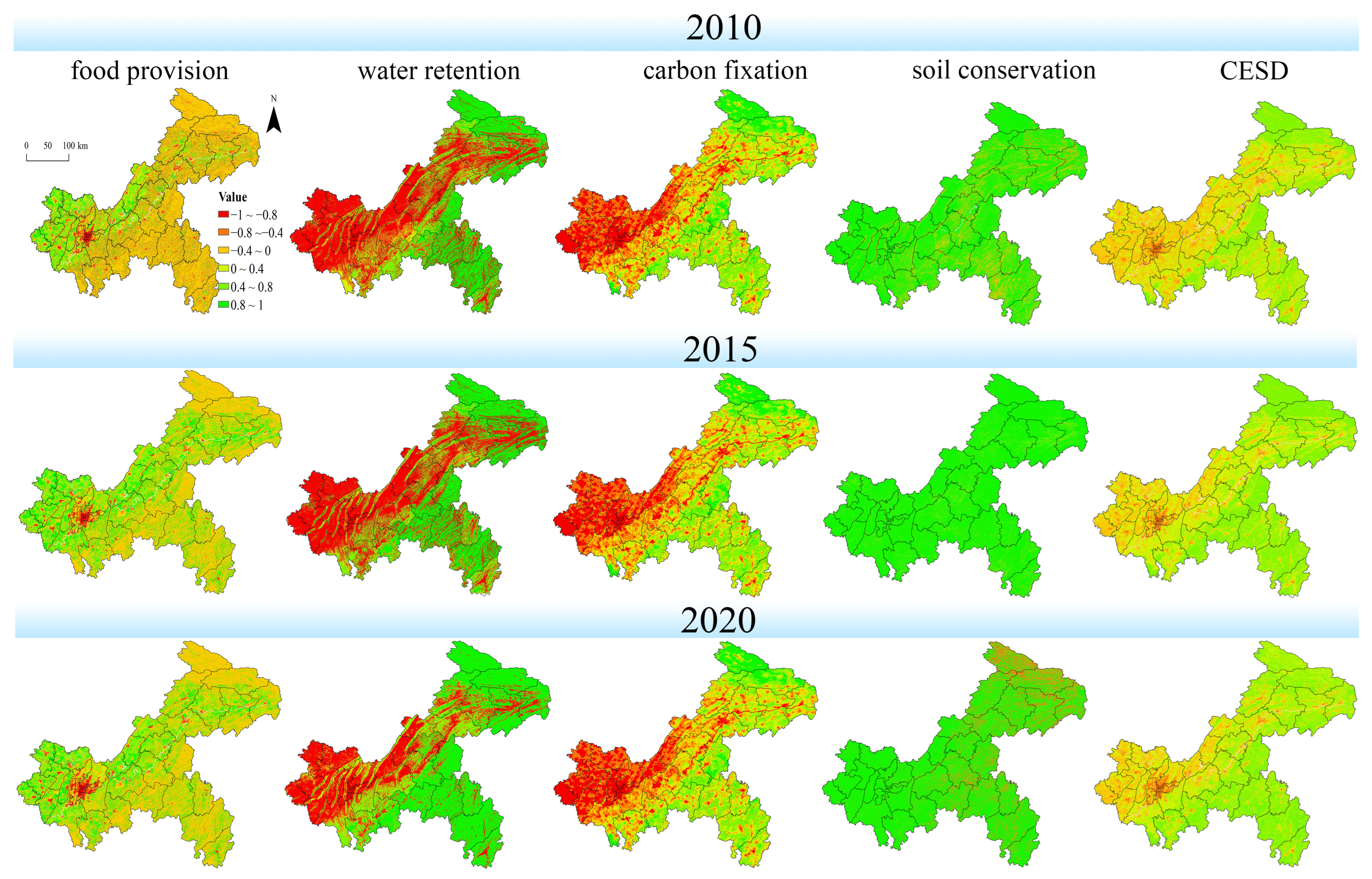

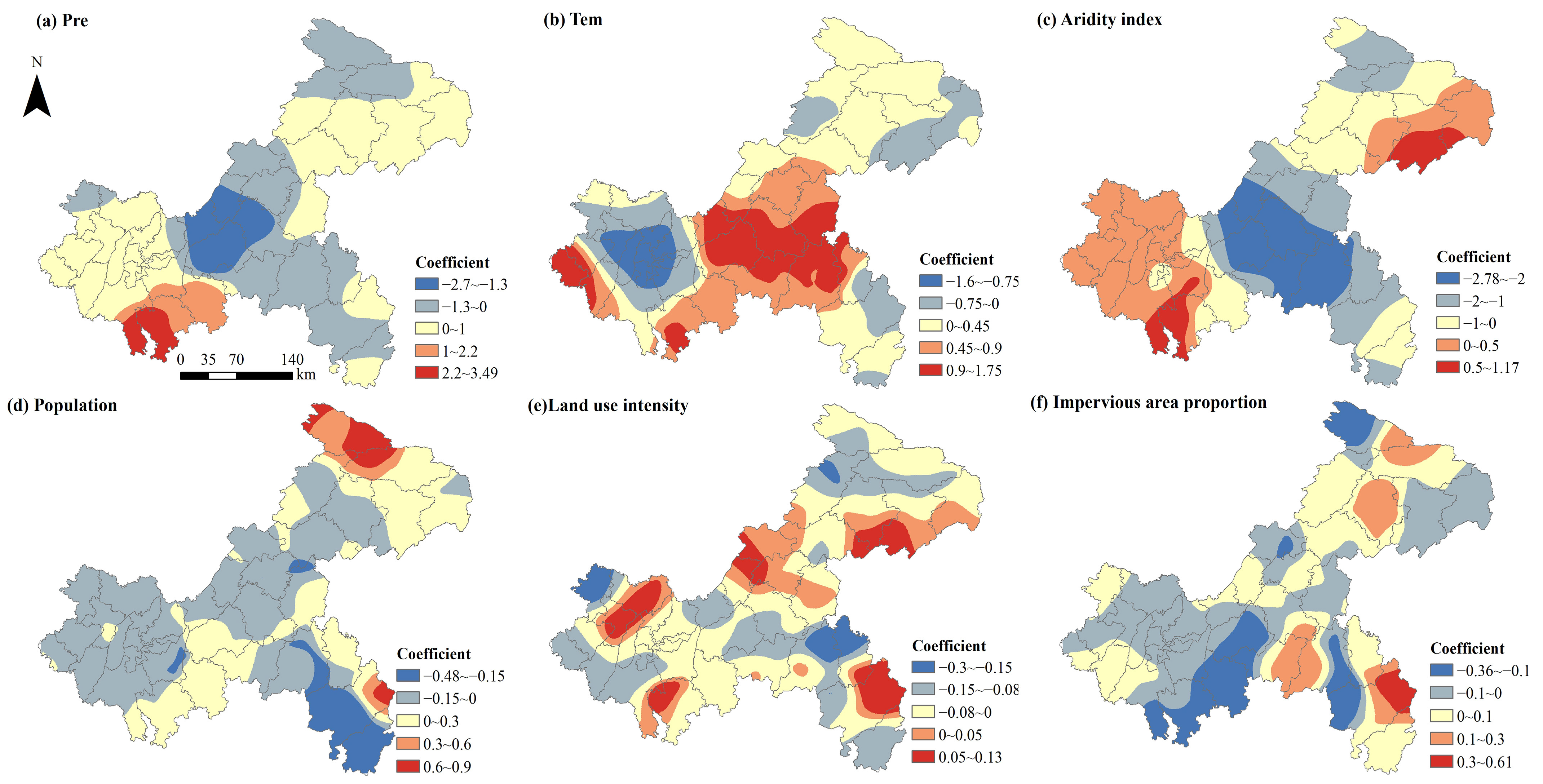
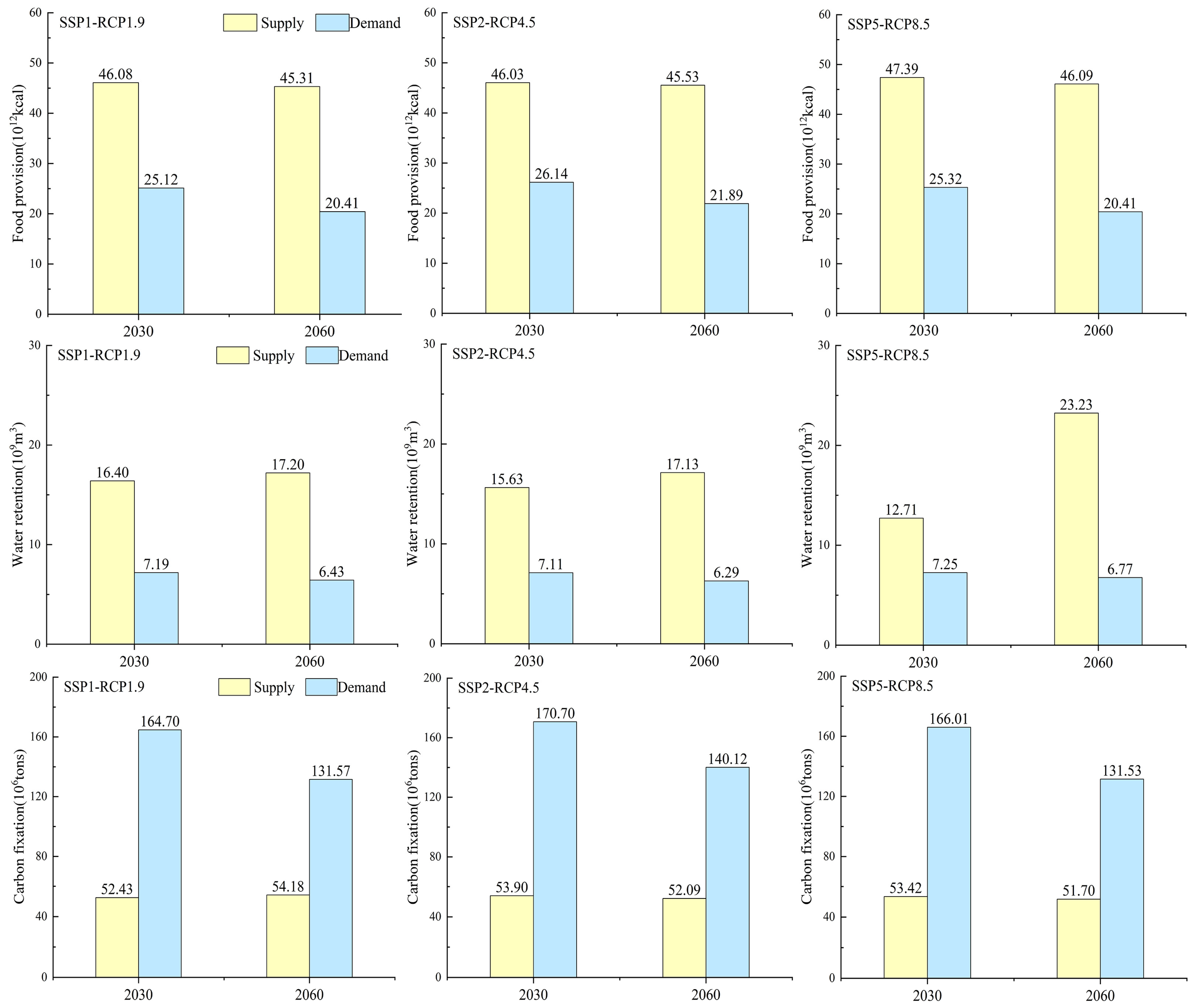
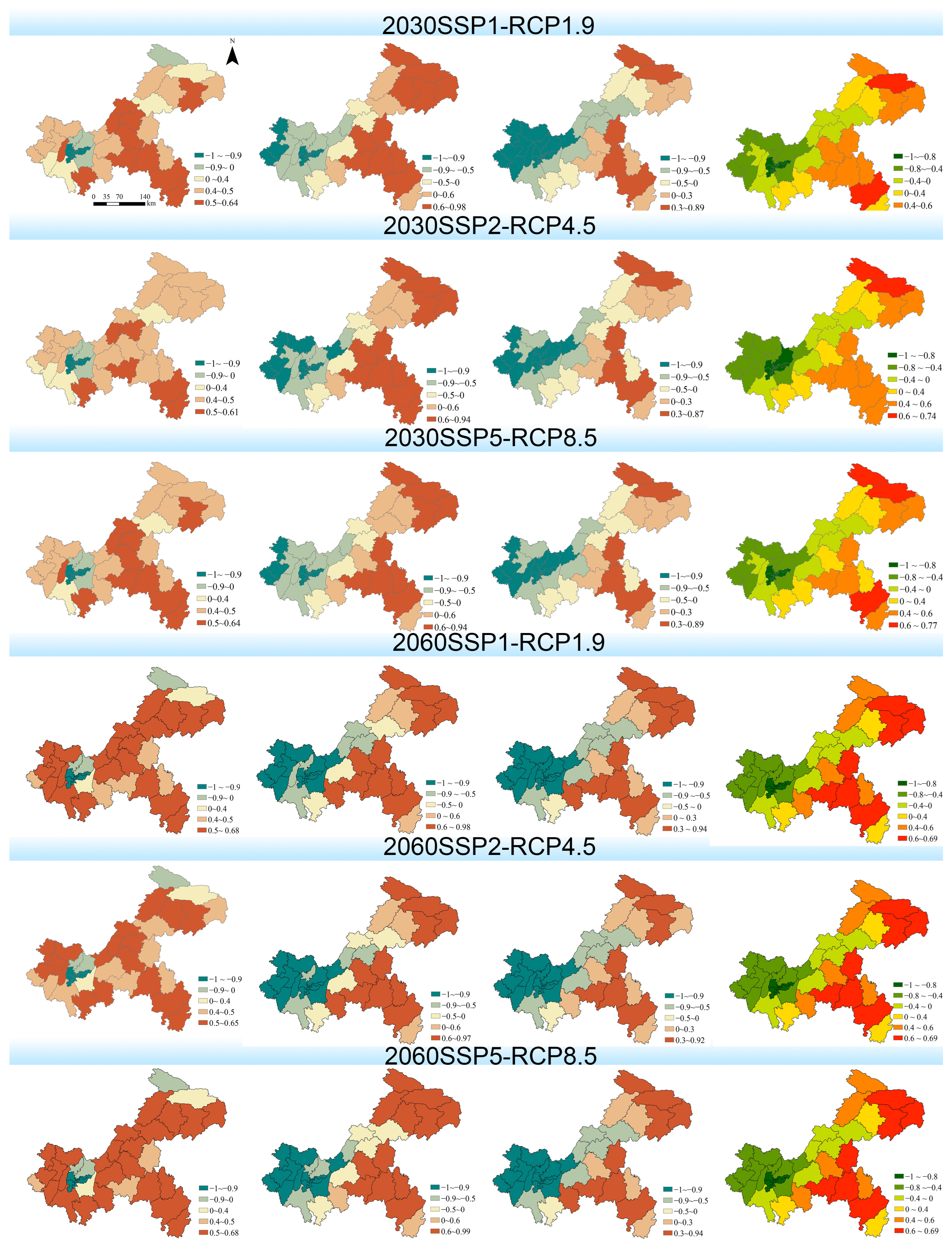
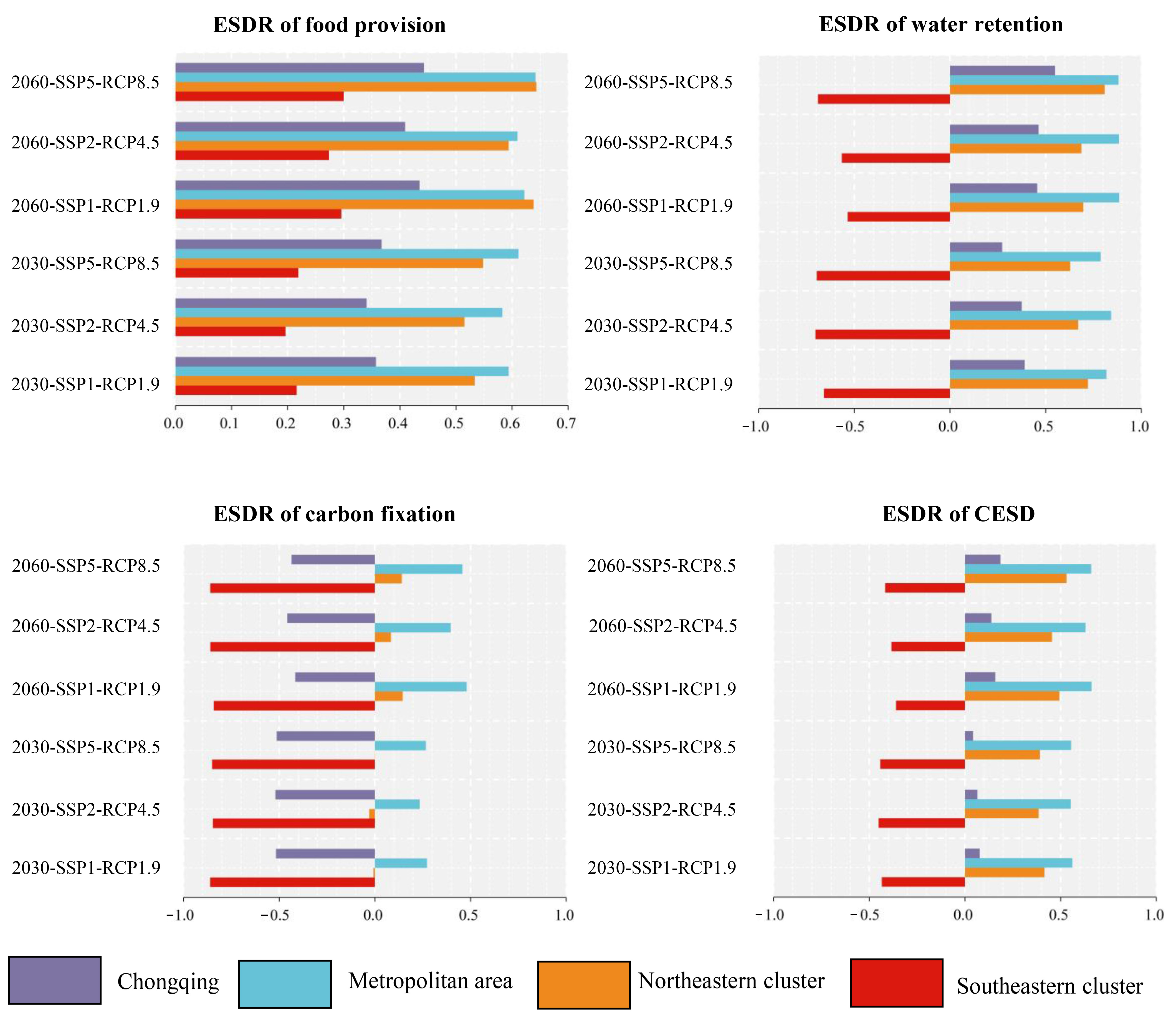
| Supply | Demand | Supply and Demand Gap | |||||||
|---|---|---|---|---|---|---|---|---|---|
| 2010 | 2015 | 2020 | 2010 | 2015 | 2020 | 2010 | 2015 | 2020 | |
| Food provision (1012 Kcal) | 46.0 | 53.2 | 54.6 | 24.0 | 23.1 | 25.2 | 22.0 | 30.0 | 20.8 |
| Water retention (108 m3) | 233.91 | 498.45 | 420.17 | 86.39 | 78.98 | 65.56 | 147.52 | 419.48 | 354.62 |
| Carbon fixation (106 tons) | 55.2 | 56.1 | 56.2 | 146.1 | 140.8 | 157.9 | −90.8 | −90.4 | −101.9 |
| Soil conservation (104 tons) | 126,496 | 164,252 | 184,183 | 5158 | 23,761 | 34,045 | 102,734 | 159,094 | 150,138 |
Disclaimer/Publisher’s Note: The statements, opinions and data contained in all publications are solely those of the individual author(s) and contributor(s) and not of MDPI and/or the editor(s). MDPI and/or the editor(s) disclaim responsibility for any injury to people or property resulting from any ideas, methods, instructions or products referred to in the content. |
© 2025 by the authors. Licensee MDPI, Basel, Switzerland. This article is an open access article distributed under the terms and conditions of the Creative Commons Attribution (CC BY) license (https://creativecommons.org/licenses/by/4.0/).
Share and Cite
Duan, Y.; Wu, W.; Xiao, R.; Jiang, H.; Wang, B. Optimizing Ecological Management in China: Insights from Chongqing’s Service Projections. Land 2025, 14, 788. https://doi.org/10.3390/land14040788
Duan Y, Wu W, Xiao R, Jiang H, Wang B. Optimizing Ecological Management in China: Insights from Chongqing’s Service Projections. Land. 2025; 14(4):788. https://doi.org/10.3390/land14040788
Chicago/Turabian StyleDuan, Yang, Wenjun Wu, Rufeng Xiao, Hongqiang Jiang, and Bo Wang. 2025. "Optimizing Ecological Management in China: Insights from Chongqing’s Service Projections" Land 14, no. 4: 788. https://doi.org/10.3390/land14040788
APA StyleDuan, Y., Wu, W., Xiao, R., Jiang, H., & Wang, B. (2025). Optimizing Ecological Management in China: Insights from Chongqing’s Service Projections. Land, 14(4), 788. https://doi.org/10.3390/land14040788






